 | | |  Solar wind Solar wind
speed: 582.6 km/sec
density: 1.2 protons/cm3
explanation | more data
Updated: Today at 2346 UT X-ray Solar Flares
6-hr max: A8 1830 UT Oct26
24-hr: A9 1752 UT Oct26
explanation | more data
Updated: Today at: 2359 UT  Daily Sun: 27 Oct 19 Daily Sun: 27 Oct 19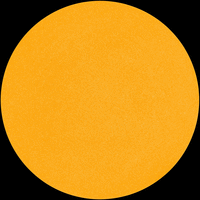 The sun is blank--no sunspots. Credit: SDO/HMI The sun is blank--no sunspots. Credit: SDO/HMI
 Sunspot number: 0
What is the sunspot number?
Updated 27 Oct 2019
Spotless Days
Current Stretch: 24 days
2019 total: 223 days (74%)
2018 total: 221 days (61%)
2017 total: 104 days (28%)
2016 total: 32 days (9%)
2015 total: 0 days (0%)
2014 total: 1 day (<1%)
2013 total: 0 days (0%)
2012 total: 0 days (0%)
2011 total: 2 days (<1%)
2010 total: 51 days (14%)
2009 total: 260 days (71%)
2008 total: 268 days (73%)
2007 total: 152 days (42%)
2006 total: 70 days (19%)
Updated 27 Oct 2019
Thermosphere Climate Index
today: 4.92x1010 W Cold
Max: 49.4x1010 W Hot (10/1957)
Min: 2.05x1010 W Cold (02/2009)
explanation | more data: gfx, txt
Updated 27 Oct 2019 The Radio Sun
10.7 cm flux: 69 sfu
explanation | more data
Updated 27 Oct 2019  Cosmic Rays Solar minimum is underway. The sun's magnetic field is weak, allowing extra cosmic rays into the solar system. Neutron counts from the University of Oulu's Sodankyla Geophysical Observatory show that cosmic rays reaching Earth in 2019 are near a Space Age peak.
Oulu Neutron Counts
Percentages of the Space Age average:
today: +9.4% High
7-day change: -0.4%
Max: +11.7% Very High (12/2009)
Min: -32.1% Very Low (06/1991)
explanation | more data
Updated 27 Oct 2019 @ 1700 UT 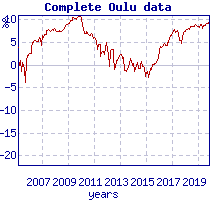
Since 2015, Earth to Sky cosmic ray balloons launched weekly from California have also detected significant increases in atmospheric radiation. Dose rates reported below are in the stratosphere at approx. 100,000 ft.
California Cosmic Ray Balloons
Monitoring started in March 2015
now: 4.64 uGy/hr High
change since 2015: +19%
Max: 4.79 uGy/hr High (10/2019)
Min: 3.80 uGy/hr Low (05/2015)
explanation | more data
Updated 19 Oct 2019 @ 0400 UT 
 Current Auroral Oval: Current Auroral Oval: Switch to: Europe, USA, New Zealand, Antarctica Credit: NOAA/Ovation  Planetary K-index Planetary K-index
Now: Kp= 3 quiet
24-hr max: Kp= 4 unsettled
explanation | more data
Interplanetary Mag. Field
Btotal: 3.3 nT
Bz: 2.0 nT north
more data: ACE, DSCOVR
Updated: Today at 2346 UT  Coronal Holes: 27 Oct 19 Coronal Holes: 27 Oct 19 
Solar wind flowing from this large coronal hole could reach Earth on Oct. 30-31. Credit: SDO/AIA  Noctilucent Clouds The northern season for noctilucent clouds has ended. NASA's AIM spacecraft is no longer detecting electric-blue clouds around the Arctic Circle. Switch view: Europe, USA, Asia, Polar Updated at: 09-03-2019 13:55:02 UT Noctilucent Clouds The northern season for noctilucent clouds has ended. NASA's AIM spacecraft is no longer detecting electric-blue clouds around the Arctic Circle. Switch view: Europe, USA, Asia, Polar Updated at: 09-03-2019 13:55:02 UT  SPACE WEATHER
NOAA Forecasts | | Updated at: 2019 Oct 27 2200 UTC FLARE | 0-24 hr | 24-48 hr | CLASS M | 01 % | 01 % | CLASS X | 01 % | 01 % |  Geomagnetic Storms: Geomagnetic Storms:
Probabilities for significant disturbances in Earth's magnetic field are given for three activity levels: active, minor storm, severe storm Updated at: 2019 Oct 27 2200 UTC Mid-latitudes | 0-24 hr | 24-48 hr | ACTIVE | 25 % | 30 % | MINOR | 10 % | 10 % | SEVERE | 01 % | 01 % | High latitudes | 0-24 hr | 24-48 hr | ACTIVE | 15 % | 15 % | MINOR | 25 % | 25 % | SEVERE | 35 % | 40 % | | | |  | | | | | | | | | | | Solar minimum is here - but even now strangely beautiful auroras are dancing around the poles. Deep inside the Arctic Circle, the expert guides of Aurora Holidays in Utsjoki, Finland, can help you chase them. Book now! | | | A NEW HOLE IN THE SUN'S ATMOSPHERE: A new hole has opened in the sun's atmosphere, and it is spewing a stream of solar wind toward Earth. Estimated time of arrival: Oct. 30-31. Arctic sky watchers may get a treat for Halloween: Aurora Boo-realis. Aurora alerts: SMS Text. SOLAR WIND SPARKS AURORAS OVER THE USA: For the 3rd day in a row, a fast-moving stream of solar wind is blowing around Earth. This is causing minor geomagnetic storms and auroras as far south as the US-Canadian border. Last night in Michigan, a green ribbon rippled over Copper Harbor: 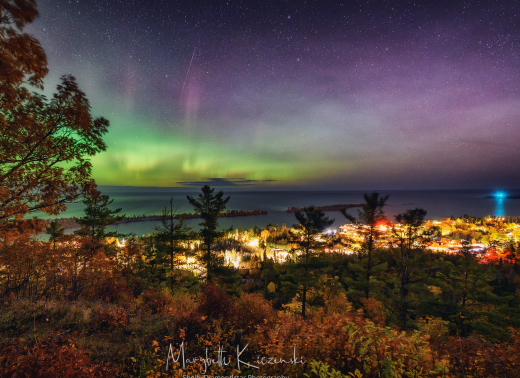
"Beautiful auroras lit up the skies around 5 a.m. EST on the shores of Lake Superior," says photographer MaryBeth Kiczenski. "What started out as a slow night ramped up into a gorgeous display."
Since the solar wind arrived on Oct. 24th, auroras have appeared over several US states. In addition to Michigan there is Montana, Washington, Minnesota--and, of course, Alaska. These sightings show that auroras may be seen at mid-latitudes even during Solar Minimum. Earth is expected to remain inside this stream for another 24 hours. More auroras over the continental USA are unlikely on Oct. 28th, because the solar wind speed is beginning to ebb, but Arctic lights are definitely in the offing. Aurora alerts: SMS Text. Realtime Spaceweather Photo Gallery
Free: Spaceweather.com Newsletter
SMOKEY PANCAKE SUNSET: Yesterday, nature photographer Mila Zinkova watched the sun set from San Francisco, and it reminded her of breakfast. "The setting sun looked like a stack of pancakes," she says. This image is a still frame from a remarkable video: 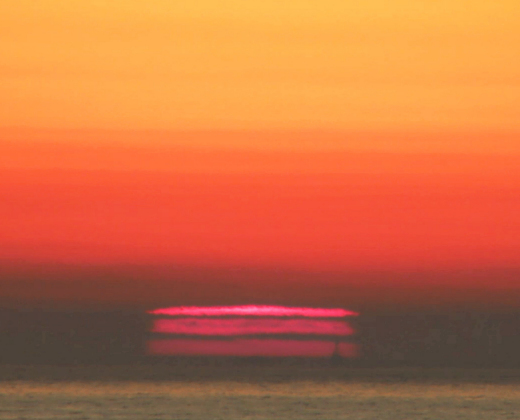
Atmospheric optics expert Les Cowley explains what happened: "Sunsets like Mila’s need a very strong temperature inversion where cold air is sandwiched between warmer air layers.The layers then act like a wave guide, ducting the sun's rays in layers. Short ducts give three pancake-like mirages. Very long ducts give the rare Novaya Zemlya effect with a whole shimmering stack of narrow stripes." The colors of the sunset come from smokey wildfires currently raging through northern California. "There is so much smoke in San Francisco right now, I felt sure that images of the miraged sun would not be able to penetrate that smoky darkness of the duct just above the horizon," says Zinkova. "However, the sun won. It was like a miracle, a sign of hope that the fire will retreat." Realtime Spaceweather Photo Gallery
Free: Spaceweather.com Newsletter THE SUNFLOWER SPACE PENDANT: Are you looking for a far-out gift? Consider the sunflower space pendant. On Oct. 18, 2019, the students of Earth to Sky Calculus launched a cosmic ray balloon to the stratosphere. This cheerful pendant went along for the ride, 109,923 feet high: 
You can have it for $109.92 (its altitude divided by 1000). The students are selling these pendants to support their cosmic ray ballooning program. Each rose gold-plated pendant comes with a greeting card showing the flower in flight and telling the story of its journey to the edge of space and back again. They make great birthday, anniversary and Christmas gifts. Far Out Gifts: Earth to Sky Store
All sales support hands-on STEM education
Realtime Aurora Photo Gallery
Free: Spaceweather.com Newsletter
Every night, a network of NASA all-sky cameras scans the skies above the United States for meteoritic fireballs. Automated software maintained by NASA's Meteoroid Environment Office calculates their orbits, velocity, penetration depth in Earth's atmosphere and many other characteristics. Daily results are presented here on Spaceweather.com. On Oct. 27, 2019, the network reported 26 fireballs.
(16 sporadics, 4 Orionids, 3 epsilon Geminids, 1 Leonis Minorid, 1 chi Taurid, 1 southern Taurid)  In this diagram of the inner solar system, all of the fireball orbits intersect at a single point--Earth. The orbits are color-coded by velocity, from slow (red) to fast (blue). [Larger image] [movies] Potentially Hazardous Asteroids ( PHAs) are space rocks larger than approximately 100m that can come closer to Earth than 0.05 AU. None of the known PHAs is on a collision course with our planet, although astronomers are finding new ones all the time. On October 27, 2019 there were 2018 potentially hazardous asteroids.
 | Recent & Upcoming Earth-asteroid encounters: | Asteroid | Date(UT) | Miss Distance | Velocity (km/s) | Diameter (m) | | 2019 UM2 | 2019-Oct-22 | 10.2 LD | 3.7 | 7 | | 2019 UT | 2019-Oct-22 | 2.4 LD | 11.2 | 9 | | 2019 UW8 | 2019-Oct-22 | 2.1 LD | 24.5 | 32 | | 2019 UF1 | 2019-Oct-22 | 6.5 LD | 16.8 | 25 | | 2019 UT5 | 2019-Oct-22 | 1.1 LD | 14.5 | 8 | | 2019 UF5 | 2019-Oct-22 | 3.7 LD | 12.1 | 28 | | 2019 UX6 | 2019-Oct-23 | 9.6 LD | 4.5 | 15 | | 2019 UJ1 | 2019-Oct-23 | 4.5 LD | 12 | 11 | | 2019 UN8 | 2019-Oct-23 | 0.9 LD | 19.2 | 4 | | 2019 UZ | 2019-Oct-23 | 5.7 LD | 9.6 | 10 | | 2019 UH | 2019-Oct-24 | 5 LD | 13.2 | 26 | | 2019 UW7 | 2019-Oct-24 | 3.3 LD | 10.1 | 13 | | 2019 UD | 2019-Oct-24 | 8.6 LD | 3.1 | 14 | | 2019 UD3 | 2019-Oct-24 | 4 LD | 12 | 25 | | 2019 UA2 | 2019-Oct-25 | 9.3 LD | 8.8 | 15 | | 2019 UW6 | 2019-Oct-25 | 9.7 LD | 11.3 | 17 | | 2019 TQ2 | 2019-Oct-25 | 12.8 LD | 12.4 | 35 | | 2019 UQ | 2019-Oct-25 | 4.3 LD | 12.9 | 20 | | 2019 UO8 | 2019-Oct-25 | 0.4 LD | 25.3 | 5 | | 162082 | 2019-Oct-25 | 16.2 LD | 11.2 | 589 | | 2017 TG5 | 2019-Oct-25 | 14.4 LD | 11.9 | 34 | | 2019 UT7 | 2019-Oct-25 | 3.4 LD | 9.9 | 16 | | 2019 UB6 | 2019-Oct-25 | 1.7 LD | 8 | 8 | | 2019 UO5 | 2019-Oct-26 | 19.3 LD | 10.5 | 27 | | 2019 UD2 | 2019-Oct-26 | 12.2 LD | 7.7 | 17 | | 2016 TH94 | 2019-Oct-26 | 11 LD | 14 | 41 | | 2019 UU5 | 2019-Oct-26 | 15.2 LD | 7.2 | 31 | | 2019 UY7 | 2019-Oct-27 | 1.4 LD | 10.8 | 12 | | 2019 UC2 | 2019-Oct-27 | 16.6 LD | 6.7 | 15 | | 2019 UJ6 | 2019-Oct-27 | 4.1 LD | 7.7 | 22 | | 2019 UD7 | 2019-Oct-27 | 1.9 LD | 13.5 | 9 | | 2019 UT1 | 2019-Oct-28 | 4.7 LD | 8.8 | 11 | | 2019 UE1 | 2019-Oct-28 | 8.6 LD | 6.8 | 24 | | 2019 UC | 2019-Oct-29 | 2.9 LD | 8.9 | 52 | | 2019 TR2 | 2019-Oct-29 | 19.4 LD | 13.8 | 75 | | 2019 US8 | 2019-Oct-29 | 0.5 LD | 10.6 | 6 | | 2019 UB8 | 2019-Oct-29 | 0.5 LD | 10.6 | 6 | | 2019 UL5 | 2019-Oct-29 | 3.9 LD | 5.3 | 11 | | 2019 UT8 | 2019-Oct-29 | 2.8 LD | 15.7 | 13 | | 2019 UB2 | 2019-Oct-29 | 15.2 LD | 8.4 | 24 | | 2019 UH7 | 2019-Oct-30 | 10 LD | 6.2 | 10 | | 2019 UM8 | 2019-Oct-30 | 5.9 LD | 7 | 7 | | 2019 UJ3 | 2019-Oct-31 | 7.3 LD | 8.6 | 23 | | 2019 UP7 | 2019-Nov-01 | 15.4 LD | 9.4 | 24 | | 2019 UM4 | 2019-Nov-01 | 11.1 LD | 9.2 | 22 | | 2019 UU3 | 2019-Nov-02 | 13.2 LD | 13.8 | 28 | | 2015 JD1 | 2019-Nov-03 | 12.9 LD | 11.9 | 269 | | 2019 UL8 | 2019-Nov-03 | 2.8 LD | 12.8 | 19 | | 2019 UH3 | 2019-Nov-03 | 10.4 LD | 8.5 | 24 | | 2019 UH5 | 2019-Nov-05 | 13.4 LD | 3.5 | 12 | | 2019 UL4 | 2019-Nov-07 | 16.6 LD | 9 | 29 | | 2019 UO7 | 2019-Nov-07 | 3.8 LD | 4.1 | 10 | | 2019 UR4 | 2019-Nov-08 | 7.4 LD | 4.5 | 15 | | 2019 UB7 | 2019-Nov-10 | 13.7 LD | 17.5 | 53 | | 2010 JG | 2019-Nov-12 | 19.6 LD | 14.9 | 235 | | 2019 UH1 | 2019-Nov-13 | 9.5 LD | 9.1 | 48 | | 2019 UE8 | 2019-Nov-15 | 7.7 LD | 6.7 | 27 | | 2019 UR2 | 2019-Nov-18 | 18 LD | 13.4 | 124 | | 2019 UK6 | 2019-Nov-20 | 15.4 LD | 7.7 | 64 | | 481394 | 2019-Nov-21 | 11.3 LD | 7.9 | 372 | | 2008 EA9 | 2019-Nov-23 | 10.5 LD | 2.2 | 10 | | 2017 AP4 | 2019-Dec-03 | 8.5 LD | 7.5 | 15 | | 2018 XW2 | 2019-Dec-07 | 17.4 LD | 13 | 28 | | 216258 | 2019-Dec-20 | 15.3 LD | 11.8 | 324 | | 2013 XY20 | 2019-Dec-21 | 18.4 LD | 1.9 | 28 | | 2017 XQ60 | 2019-Dec-22 | 11 LD | 15.6 | 47 | Notes: LD means "Lunar Distance." 1 LD = 384,401 km, the distance between Earth and the Moon. 1 LD also equals 0.00256 AU. MAG is the visual magnitude of the asteroid on the date of closest approach. | | Cosmic Rays in the Atmosphere | SOMETHING NEW! We have developed a new predictive model of aviation radiation. It's called E-RAD--short for Empirical RADiation model. We are constantly flying radiation sensors onboard airplanes over the US and and around the world, so far collecting more than 22,000 gps-tagged radiation measurements. Using this unique dataset, we can predict the dosage on any flight over the USA with an error no worse than 15%. E-RAD lets us do something new: Every day we monitor approximately 1400 flights criss-crossing the 10 busiest routes in the continental USA. Typically, this includes more than 80,000 passengers per day. E-RAD calculates the radiation exposure for every single flight. The Hot Flights Table is a daily summary of these calculations. It shows the 5 charter flights with the highest dose rates; the 5 commercial flights with the highest dose rates; 5 commercial flights with near-average dose rates; and the 5 commercial flights with the lowest dose rates. Passengers typically experience dose rates that are 20 to 70 times higher than natural radiation at sea level. To measure radiation on airplanes, we use the same sensors we fly to the stratosphere onboard Earth to Sky Calculus cosmic ray balloons: neutron bubble chambers and X-ray/gamma-ray Geiger tubes sensitive to energies between 10 keV and 20 MeV. These energies span the range of medical X-ray machines and airport security scanners. Column definitions: (1) The flight number; (2) The maximum dose rate during the flight, expressed in units of natural radiation at sea level; (3) The maximum altitude of the plane in feet above sea level; (4) Departure city; (5) Arrival city; (6) Duration of the flight. SPACE WEATHER BALLOON DATA: Approximately once a week, Spaceweather.com and the students of Earth to Sky Calculus fly space weather balloons to the stratosphere over California. These balloons are equipped with radiation sensors that detect cosmic rays, a surprisingly "down to Earth" form of space weather. Cosmic rays can seed clouds, trigger lightning, and penetrate commercial airplanes. Furthermore, there are studies ( #1, #2, #3, #4) linking cosmic rays with cardiac arrhythmias and sudden cardiac death in the general population. Our latest measurements show that cosmic rays are intensifying, with an increase of more than 18% since 2015: 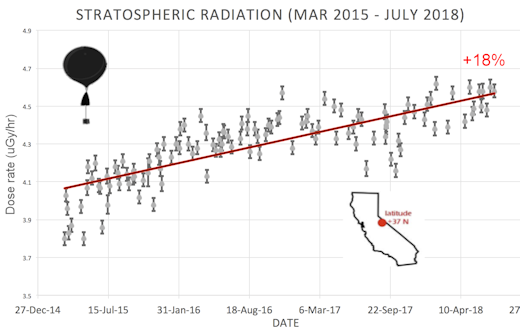
The data points in the graph above correspond to the peak of the Reneger-Pfotzer maximum, which lies about 67,000 feet above central California. When cosmic rays crash into Earth's atmosphere, they produce a spray of secondary particles that is most intense at the entrance to the stratosphere. Physicists Eric Reneger and Georg Pfotzer discovered the maximum using balloons in the 1930s and it is what we are measuring today. En route to the stratosphere, our sensors also pass through aviation altitudes: 
In this plot, dose rates are expessed as multiples of sea level. For instance, we see that boarding a plane that flies at 25,000 feet exposes passengers to dose rates ~10x higher than sea level. At 40,000 feet, the multiplier is closer to 50x. The radiation sensors onboard our helium balloons detect X-rays and gamma-rays in the energy range 10 keV to 20 MeV. These energies span the range of medical X-ray machines and airport security scanners. Why are cosmic rays intensifying? The main reason is the sun. Solar storm clouds such as coronal mass ejections (CMEs) sweep aside cosmic rays when they pass by Earth. During Solar Maximum, CMEs are abundant and cosmic rays are held at bay. Now, however, the solar cycle is swinging toward Solar Minimum, allowing cosmic rays to return. Another reason could be the weakening of Earth's magnetic field, which helps protect us from deep-space radiation. | | The official U.S. government space weather bureau | | | The first place to look for information about sundogs, pillars, rainbows and related phenomena. | | | Researchers call it a "Hubble for the sun." SDO is the most advanced solar observatory ever. | | | 3D views of the sun from NASA's Solar and Terrestrial Relations Observatory | | | Realtime and archival images of the Sun from SOHO. | | | from the NOAA Space Environment Center | | | fun to read, but should be taken with a grain of salt! Forecasts looking ahead more than a few days are often wrong. | | | from the NOAA Space Environment Center | | | the underlying science of space weather |  | To find reviews of new online casino sites in the UK try The Casino DB where there are hundreds of online casino reviews complete with bonuses and ratings. Looking for a new online casino? Try Casimpo the new site dedicated to making online casino simple and easy for all. | | | These links help Spaceweather.com stay online. Thank you to our supporters! | | | | | | | | |  | |  |   | ©2019 Spaceweather.com. All rights reserved. This site is penned daily by Dr. Tony Phillips. | |

